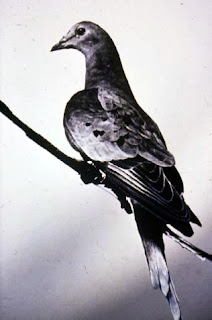PASSENGER PIGEON - PART 1
5 billion is a large number, and that is about how many passenger pigeons were once thought to flood the skies in the eastern part of the United States. The male Passenger Pigeon was 16 inches long with a bluish gray head and orange chest. Their back was an olive color with black spots. The female was slightly smaller and all that olive color. The Passenger Pigeon were a very speedy bird, clocking in at 62 mph.
The Passenger Pigeon gets its name from the French word, passager, which means "passing by" because huge flocks were always migrating or passing through. In fact, in Ontario in 1866 one flock was estimated to be one mile wide and 300 miles wide. It blacked the sky for 14 straight hours and scientists estimate this one flock may have held 3.5 billion pigeons. It was also reported that after one of these immense flocks past it looked like it had snowed because of all of the poop left behind.
The Passenger Pigeons large numbers and extremely social behavior may have been its Achilles heal. Their breeding colonies were so thick that tree branches would often break under the weight of so many nests. Hunters soon started gathering huge numbers of Passenger Pigeons to sell as a food source for people in growing cities along the Eastern seaboard. They even had hunting competitions in which the winner killed 30,000 birds. Hunts would soak grain in alcohol and then net the inebriated birds that couldn't fly.
Taking advantage of their social behavior, hunters would capture a bird, tie its leg to a stool and place it in an open field. Other Passenger Pigeons would respond to the distressed bird, only to be shot or netted. It is thought that this is where we get the term "stool pigeon".
By the 1870's the population was starting to show signs of diminishing. The reduction in population seemed to affect their ability to breed, which further shrunk the population. The last wild Passenger Pigeon was shot in Ohio in 1900. This left only a few remaining birds left in zoos.
Martha, the last Passenger Pigeon died in the Cincinnati Zoo on September 1, 1914 at 1pm.
The demise of the Passenger Pigeon left a nation in shock. Many people couldn't believe that the once sky darkening, plentiful Passenger Pigeon had gone the way of the dodo. It couldn't be blamed on anything except the people who had hunted it so mercilessly for so long. The extinction of the Passenger Pigeon did get people to take note about the need for laws and regulations to keep other plentiful species from following suit. Their extinction may have saved white tail deer, alligators, and wild turkeys from facing the same fate of over hunting.
Additional Information:
http://www.nhm.ac.uk/natureplus/blogs/behind-the-scenes/2014/09/01/100-passenger-pigeon-facts-on-the-100th-anniversary-of-its-extinction?fromGateway=true
http://www.birdorable.com/blog/martha-week-10-passenger-pigeon-facts/

http://cincinnatizoo.org/blog/2014/08/26/cincinnati-zoo-remembers-martha-the-worlds-last-passenger-pigeon/
http://foldtheflock.org/ (origami passenger pigeons)
The Passenger Pigeon gets its name from the French word, passager, which means "passing by" because huge flocks were always migrating or passing through. In fact, in Ontario in 1866 one flock was estimated to be one mile wide and 300 miles wide. It blacked the sky for 14 straight hours and scientists estimate this one flock may have held 3.5 billion pigeons. It was also reported that after one of these immense flocks past it looked like it had snowed because of all of the poop left behind.
The Passenger Pigeons large numbers and extremely social behavior may have been its Achilles heal. Their breeding colonies were so thick that tree branches would often break under the weight of so many nests. Hunters soon started gathering huge numbers of Passenger Pigeons to sell as a food source for people in growing cities along the Eastern seaboard. They even had hunting competitions in which the winner killed 30,000 birds. Hunts would soak grain in alcohol and then net the inebriated birds that couldn't fly.
Taking advantage of their social behavior, hunters would capture a bird, tie its leg to a stool and place it in an open field. Other Passenger Pigeons would respond to the distressed bird, only to be shot or netted. It is thought that this is where we get the term "stool pigeon".
By the 1870's the population was starting to show signs of diminishing. The reduction in population seemed to affect their ability to breed, which further shrunk the population. The last wild Passenger Pigeon was shot in Ohio in 1900. This left only a few remaining birds left in zoos.
Martha, the last Passenger Pigeon died in the Cincinnati Zoo on September 1, 1914 at 1pm.
The demise of the Passenger Pigeon left a nation in shock. Many people couldn't believe that the once sky darkening, plentiful Passenger Pigeon had gone the way of the dodo. It couldn't be blamed on anything except the people who had hunted it so mercilessly for so long. The extinction of the Passenger Pigeon did get people to take note about the need for laws and regulations to keep other plentiful species from following suit. Their extinction may have saved white tail deer, alligators, and wild turkeys from facing the same fate of over hunting.
Additional Information:
http://www.nhm.ac.uk/natureplus/blogs/behind-the-scenes/2014/09/01/100-passenger-pigeon-facts-on-the-100th-anniversary-of-its-extinction?fromGateway=true
http://www.birdorable.com/blog/martha-week-10-passenger-pigeon-facts/

http://cincinnatizoo.org/blog/2014/08/26/cincinnati-zoo-remembers-martha-the-worlds-last-passenger-pigeon/
http://foldtheflock.org/ (origami passenger pigeons)
 |
| Painting of a Passenger Pigeon Flock |
 |
| Birdorable's 100 year extinction tribute |
 |
| Former Passenger Pigeon Range |
 |
| Picture of Martha at the Cincinnati Zoo |






Comments
Post a Comment